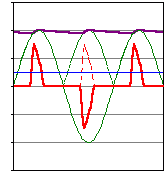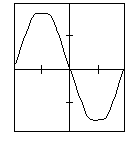|
Now I have heard many a speaker at some talk, workshop, or conference on power and power quality blurt out, in full confidence, "if it ain't a sinewave, it ain't linear!". I think we all agree; Place a perfect resistor (if there is such a thing) across a feed voltage and the current curve will follow the voltage curve exactly. No deviations. In fact, if one had a good quality dual-trace oscilloscope, one could, by tweaking the gain and trace positions, superimpose the one waveform on the other and make it appear as one single waveform. Let us now examine what our world is really made of being capacitors and inductors, not forgetting that these are often coupled with resistors too. I am, for the moment, assuming pure capacitance, pure inductance, pure resistance, and (while I'm seeking perfection) I'm assuming a pure sinewave applied voltage. No matter how much I tweak the gain and position of the traces of the oscilloscope, I am unable to superimpose the current curve of the capacitor or inductor as the current curve is either leading (capacitor) or lagging (inductor) the voltage curve. Using our definition that a linear load allows the current curve to be superimposed on the voltage curve, the fact we cannot do this means the load characteristic of a capacitor or inductor must therefore be non-linear. Yet, if we upgrade our oscilloscope to one that allows time delay on the inputs, we would be able to add delay to the current curve in the case of the capacitor, or delay to the voltage curve in the case of the inductor, and achieve the same result of a single trace as was done with the resistor. Back to our definition; As we can achieve perfect superimposing of the two curves thus proves the load characteristic of capacitors and inductors is actually linear. The only difference here is a time difference in the two curves (in the case of perfect capacitors and inductors) of 90 degrees (5ms at 50Hz). And even if we add resistance, either in series or parallel with the capacitor or inductor, the only difference we are going to make is moving the current curve closer, in time, to the voltage curve. We will always be able to tweak the appropriate gains, positions, and delays and have two perfectly superimposed waveforms. So, with a pure source (which would have zero ohms feed impedance), the voltage would be a perfect sinewave and the current curve would be an exact copy i.e. a perfect sinewave too, but not necessarily in phase.
Oh, what it is to be able to dream. Sorry folks, but it is time to not only smell the coffee, but to have a good swig of caffeine too! Time to get back to reality! This is where a pure electronics perspective takes best place. You may have heard of the area of power engineering called "harmonics" (this is covered in the next section), but before we can even discuss this we need to understand the concept behind load linearity and how it is perpetuated. And yes, the correct term for waveform impurity is 'distortion'. I would like to take this opportunity to introduce you to the humble diode. It started life as a filament that spewed out electrons that were collected by a plate. This then advanced into a controllable diode by placing a grid between the electron source and collector. Technology was born. It now comes in all shapes and sizes. Rectifiers, zeners, transistors, thyristors (to name a few), and then they packaged them together and call this ensemble an 'integrated circuit'. It is believed to be a chap called Edison who founded this (Fleming improved on what Edison had discovered), and can imagine how he would feel if he could see what has been accomplished! Think about the number of controllable diodes (transistors) being used to bring this page to the screen in front of you! The number would be staggering. But let's return to the diode. Its main function in life is to rectify. Although this is a distinct advantage, it does bring with it a serious number of issues. The primary one is it does not always conduct (we don't want it to). When used with even the purist resistive load it can turn it into one that would not even closely resemble a resistor, no matter how hard it tried. This fact alone keeps many employed in the massive industry built around 'harmonics'. Now, just imagine what happens when we add the complication of controlling the mighty 'D'. Hi-tech loads interface with the mains supply via the humble diode (usually four of them configured as a 'bridge rectifier') as the first components followed by smoothing capacitors (ok, there is a filter in between the mains and diodes, but has little bearing in this instance).
Also shown is the output from the capacitor (Purple). The changes that occur from one half cycle to the next is referred to as "ripple", the depth of the ripple being referred to as the 'ripple voltage'. But nothing is perfect. If it is realized that the source is not zero ohms then it can be realized that it can be affected by varying load. The higher a load the more it can lower the voltage as a direct result of impedance. As the load no longer acts as a resistor and changes impedance during the cycle, things become interesting.
The distortion figure is calculated by taking the input signal and comparing it to a pure sinewave equal in RMS of the input signal, the RMS of the difference then presented as a percentage of the input RMS. Before we leave this subject, it may prove prudent to focus on one aspect of the current curve of hi-tech loads (referring to the waveforms above). It will be noticed the current waveform peak actually leads the voltage waveform (the peak of the current waveform is before the peak of the input voltage). This occurs as a direct result of the ripple as the diodes will start to conduct some time ahead of the peak of the input voltage as it charges a now fractionally discharged capacitor. The current falls to zero soon after the peak as the input voltage falls away leaving behind a capacitor that is retaining the charge. A simpler way of explaining this is the diodes are nothing more than an AC to DC switching system followed by a capacitor resulting, therefore, in the load appearing capacitive. With modern power supplies having even smaller smoothing capacitors, this capacitive characteristic has moved from about 0.85 leading to about 0.6 leading! The collective load of a site is typically inductive (lagging) meaning such loads help to compensate thus leaving the user with a current angle closer to unity. However, vast areas of hi-tech load (such as a data centre) usually fall foul of this with standard power factor correction units unable to compensate (being capacitors themselves). Modern active harmonic filters are, by nature of their design, able to do something about it (yes, sometimes it does takes hi-tech to fix hi-tech!).
Note what was not said when introducing the resistor (at the top of the page) as a linear load; Nothing was said about the voltage curve being a perfect sinewave! It was simply stated that the current curve would be a perfect replica of the voltage curve, and it is this characteristic that makes the load, in this case the resistor, linear. We have seen that in real life the input voltage can be extremely flat-topped. This would therefore make a sinewave current curve demanding excess current at the peak i.e. more than the source is expecting to deliver! This clearly shows the statement "if it's a sinewave, it's linear!" is grossly flawed. Also, linearity has nothing to do with current angle i.e. the standard thinking on power factor. A non-linear load can have a perfect current angle i.e. neither inductive nor capacitive, yet still have a power factor. Don't confuse the two issues! Keep this in mind as we investigate further.
© 28.02.02 / 29.03.05 |
 Causes:- Issues with
Causes:- Issues with Alongside is a graphical representation of the current curves of an input rectifier system (Red) with respect to the voltage presented (Green). The middle waveform showing both the AC and rectified DC output. The Blue line shows the RMS current value.
Alongside is a graphical representation of the current curves of an input rectifier system (Red) with respect to the voltage presented (Green). The middle waveform showing both the AC and rectified DC output. The Blue line shows the RMS current value.  When the source is subjected to this imperfect impedance it too deviates from a sinewave but complimentary to the current curve i.e. when the current goes up during the cycle the voltage is pulled down. If sufficient current is drawn about the peak the voltage can suffer what is known as "flat-topping", an oscilloscope snapshot shown alongside.
When the source is subjected to this imperfect impedance it too deviates from a sinewave but complimentary to the current curve i.e. when the current goes up during the cycle the voltage is pulled down. If sufficient current is drawn about the peak the voltage can suffer what is known as "flat-topping", an oscilloscope snapshot shown alongside.